THREE!
*ONE. Kevin Huizenga's new minicomic is available for order online at the revived USS Catastrophe store; it follows up on the primary serial from the final issue of Or Else, so keep your copy handy.
*TWO. Brendan McCarthy's old strip from Sounds, The Electrick Hoax, is now excerpted at his site. The beginning and ending are presented, with a little stuff in between. Written with Peter Milligan. I do believe a young feller named Alan Moore (composing as: Curt Vile) started writing and drawing a strip or two right after Milligan & McCarthy left. Good reading.
*THREE. Dave Stevens' The Rocketeer is totally getting reprinted by IDW in October.
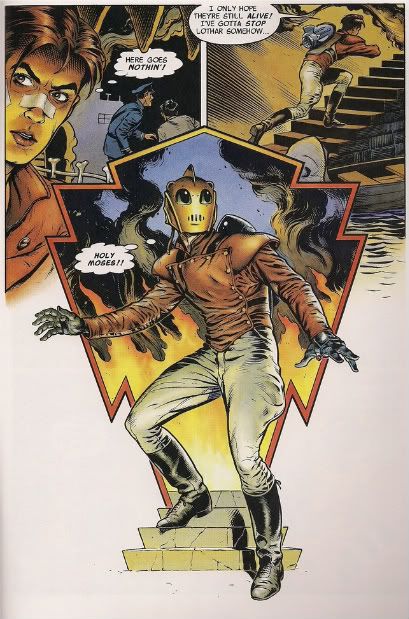
Yeah, when I mentioned that series on Monday? I had no idea about this news. Scott Dunbier is editing the project -- a plain vanilla hardcover and a 100-page heavier deluxe edition are planned -- with Laura Martin on board for a full-scale revision of the work's coloring.
I presume that last bit's intended at least partially to invest some consistency into the work's hues (although there could be source material problems too, I dunno); while loved by many, The Rocketeer was somewhat infamous in its day for slow production, slow enough that various technological leaps were made as the story went on, prompting their eventual inclusion in later chapters. Remember, this was a 'series' that ran from 1982 to 1995, to the end result of precisely 111 pages of story. It went through four publishers -- Pacific, Eclipse, Comico and Dark Horse -- and two way-out-of-print collected editions -- The Rocketeer; Eclipse, 1985 (that's Eclipse Graphic Album Series Vol. 7) and The Rocketeer: Cliff's New York Adventure; Dark Horse, 1996 -- not counting the Peter David/Russ Heath movie adaptation.
Boy, I saw that movie in theaters (one of the few, the proud) when I was nine, and I loved the hell out of it. Didn't know a damn thing about any kings of the rocket men or Rondo Hatton or anything of the little nods 'n winks toward serial adventures - just a guy with a jet on his back. Good stuff. Kind of afraid to see it as an adult; haven't.
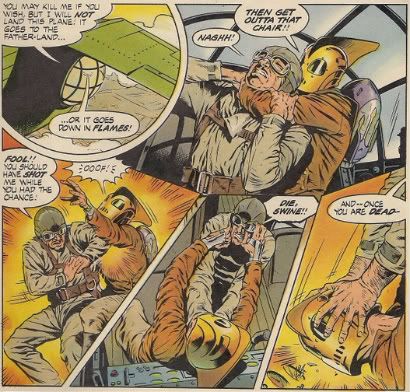
Looking at the comic as an adult, however, I'm really struck with the history. And I don't just mean the 1938 setting, or the late Stevens' famous affinity for mid-century pin-up artwork (the story's nudie model female lead is based on Bettie Page, a concept element that had to go once Disney rolled out the silver screen monies).
No, I mean the project's positioning of the costumed comic book hero as a deliberate throwback to derring-do of an earlier time, something young artists like Howard Chaykin (with The Scorpion) and Michael Wm. Kaluta (DC's initial revival of The Shadow) had been pursuing in the mid-'70s, away from the baggage of the faded superhero genre. The Rocketeer comic had been planned since 1981, positioning it just a ways past underground-mainstream 'bridge' comics like Star*Reach (which Stevens contributed to), at the head of one of the earlier Direct Market-savvy small genre publishers.
Hell, it even started out as a back-up feature in Mike Grell's Starslayer, a sword-swingin' swashbuckler IN SPACE series - there's your cheeseball past-future throwback right there, a genuine DC refugee of the genre sort that'd find much purchase on those baby comic shop shelves!
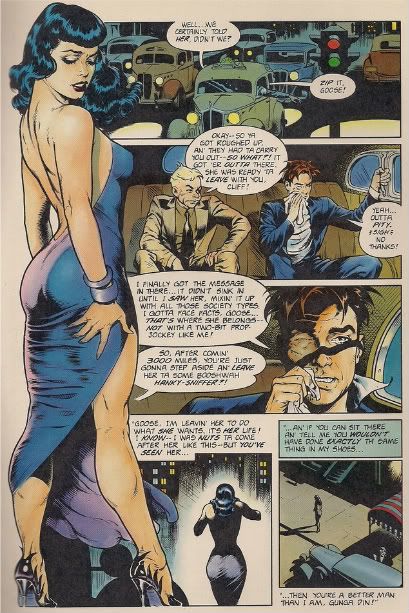
Oddly for a comic about flying, those Rocketeer pages are awfully dense. No doubt part of that's due to Stevens' love for old adventure strips and busy vintage comics and the like, but I often find myself associating such compression of knowing visual homage and stylized dialogue with the work like-minded (content-wise) artists like Chaykin & Kaluta were doing around the same time in American Flagg! and Starstruck. Not that Stevens' style was exactly like those -- although Kaluta eventually started doing page breakdowns for Stevens in the early '90s, so he's a better comparison than most -- but I think there's a similar attempt made at an overwhelming effect, here a veritable dive-bombing of adoring period detail and whimsical-dramatic splendor. It's handsome, and almost relentlessly so!
It'll probably go over well today, I think. Despite all these notions the work brings up on reflection, it does manage the fairly impressive feat of not seeming very old as you read it, and I'm sure that feeling will only intensify with Martin's unified coloring. Plus, you know... first time ever collected under one cover.
Fussy bastard that I am, however, I will sorta miss all the accompanying art you get collecting the whole affair, spread out over all those series and anthologies. The back-up features, the features Stevens was backing up... like many heroes of the Golden Age, the Rocketeer rarely flew alone. Obviously, there's Mike Grell:
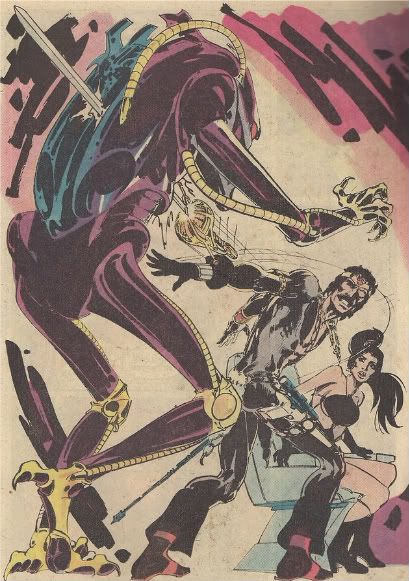
Black & purple was big in space in '82.
Later on, Comico's two issues of The Rocketeer Adventure Magazine brought the oft-mentioned Kaluta, with writing & colors by the great Elaine Lee:
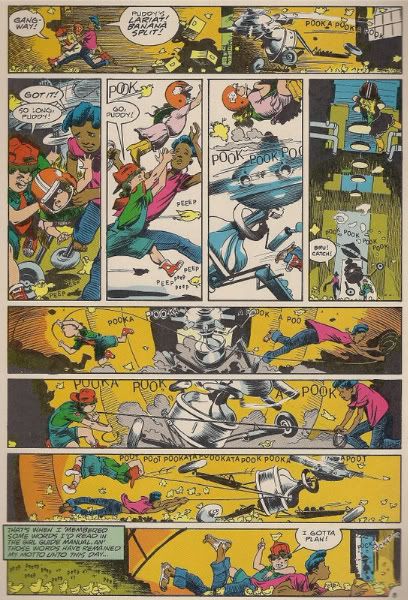
Space of a different kind!
And then there was Pacific Presents, with space given to the great one himself:
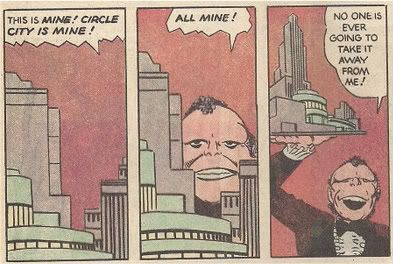
That's right, it's goddamned Steve Ditko, whipping up some early '80s adventures for The Missing Man, one of his legion of self-made superheroes. The Missing Man had debuted as a back-up in a different legend's title, Jack Kirby's Captain Victory and the Galactic Rangers, at which point Mark Evanier was scripting. Robin Snyder would later take over the dialogue, but Pacific Presents #1 had the privilege of being sheer Ditko (albeit with Steve Oliff on colors and "Cody" on letters) and all-astonishing, well beyond the Missing Man's already striking neon tube nightmare character design of disembodied cartoon limbs.
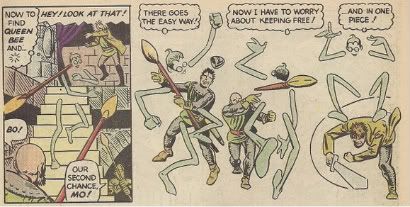
It's a special device that aids in his struggle against crime, here portrayed by rival gangs, one with a blatant feudal theme (henchmen complain about their costumes in-story). The real star, however, is the gang's Queen Bee, a dazed, tragic young woman in a mesh leotard and stripey underclothes, eyes forever hidded under harsh bangs, a pair of bee wings on her back and a powerful drone forever escaping her throat, curdled musical notes swarming around always.
She used to be a musician, since her hum could drive almost anyone to tears or ecstasy, or a place where both meet freely. She used to be in love with a guy, and wanted only to make the cash to buy a place for them both to have. Ditko never explains her abilities, or her costume, since there's no need; she's art exploited, a fine eccentric put to wicked use. The King of the gang couldn't be moved by her hum, but he knew he could profit, so he tried to kill her lover and trick her into thinking he was looking for the mystery assassin, when he was only collecting dough and consolidating power.
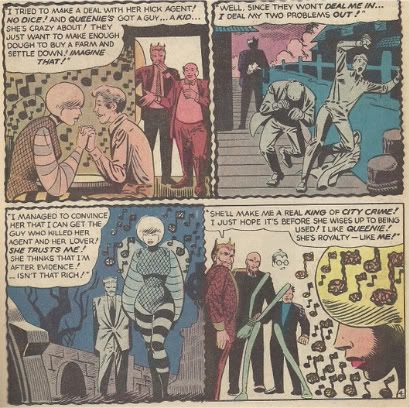
It's primal, cutting Ditkovian stuff, talent led astray to debasement, its icons idiosyncratic but intuitive, from the greasy hair-crown of the villain to the musical fog surrounding the Queen. It goes without saying that the Missing Man puts things right, slamming evil and reuniting the lovers with the aid of his oddball super-team, but the weird hurt that hangs over the proceedings is lasting, tinged with a defiance that excellence will ultimately rise, and affect.
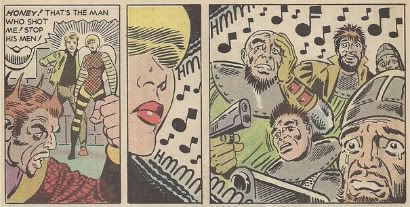
Just look at that. That last fucking panel, man. It's 180 degrees away from the kind of comic Dave Stevens was making, such a polished and coiled slick throwback machine, and very fine for it! Ditko's something else, something wholly out of time, something only ever and forever Ditko. It was great to see in the same comic, where it was sort of a back-up, but always longer than the main feature, and, at least here, more lasting in impact.
You can't have that in a book, obviously; it's be nonsense, against every expectation of the publishing culture. But the comic book culture - it has its virtues, there in the bins. Steve Ditko may dive again, but don't forget him, not while reading the newly whole Rocketeer in October or while sitting down this weekend for a little Watchmen; those Charlton characters didn't come from just anywhere.
*TWO. Brendan McCarthy's old strip from Sounds, The Electrick Hoax, is now excerpted at his site. The beginning and ending are presented, with a little stuff in between. Written with Peter Milligan. I do believe a young feller named Alan Moore (composing as: Curt Vile) started writing and drawing a strip or two right after Milligan & McCarthy left. Good reading.
*THREE. Dave Stevens' The Rocketeer is totally getting reprinted by IDW in October.

Yeah, when I mentioned that series on Monday? I had no idea about this news. Scott Dunbier is editing the project -- a plain vanilla hardcover and a 100-page heavier deluxe edition are planned -- with Laura Martin on board for a full-scale revision of the work's coloring.
I presume that last bit's intended at least partially to invest some consistency into the work's hues (although there could be source material problems too, I dunno); while loved by many, The Rocketeer was somewhat infamous in its day for slow production, slow enough that various technological leaps were made as the story went on, prompting their eventual inclusion in later chapters. Remember, this was a 'series' that ran from 1982 to 1995, to the end result of precisely 111 pages of story. It went through four publishers -- Pacific, Eclipse, Comico and Dark Horse -- and two way-out-of-print collected editions -- The Rocketeer; Eclipse, 1985 (that's Eclipse Graphic Album Series Vol. 7) and The Rocketeer: Cliff's New York Adventure; Dark Horse, 1996 -- not counting the Peter David/Russ Heath movie adaptation.
Boy, I saw that movie in theaters (one of the few, the proud) when I was nine, and I loved the hell out of it. Didn't know a damn thing about any kings of the rocket men or Rondo Hatton or anything of the little nods 'n winks toward serial adventures - just a guy with a jet on his back. Good stuff. Kind of afraid to see it as an adult; haven't.

Looking at the comic as an adult, however, I'm really struck with the history. And I don't just mean the 1938 setting, or the late Stevens' famous affinity for mid-century pin-up artwork (the story's nudie model female lead is based on Bettie Page, a concept element that had to go once Disney rolled out the silver screen monies).
No, I mean the project's positioning of the costumed comic book hero as a deliberate throwback to derring-do of an earlier time, something young artists like Howard Chaykin (with The Scorpion) and Michael Wm. Kaluta (DC's initial revival of The Shadow) had been pursuing in the mid-'70s, away from the baggage of the faded superhero genre. The Rocketeer comic had been planned since 1981, positioning it just a ways past underground-mainstream 'bridge' comics like Star*Reach (which Stevens contributed to), at the head of one of the earlier Direct Market-savvy small genre publishers.
Hell, it even started out as a back-up feature in Mike Grell's Starslayer, a sword-swingin' swashbuckler IN SPACE series - there's your cheeseball past-future throwback right there, a genuine DC refugee of the genre sort that'd find much purchase on those baby comic shop shelves!

Oddly for a comic about flying, those Rocketeer pages are awfully dense. No doubt part of that's due to Stevens' love for old adventure strips and busy vintage comics and the like, but I often find myself associating such compression of knowing visual homage and stylized dialogue with the work like-minded (content-wise) artists like Chaykin & Kaluta were doing around the same time in American Flagg! and Starstruck. Not that Stevens' style was exactly like those -- although Kaluta eventually started doing page breakdowns for Stevens in the early '90s, so he's a better comparison than most -- but I think there's a similar attempt made at an overwhelming effect, here a veritable dive-bombing of adoring period detail and whimsical-dramatic splendor. It's handsome, and almost relentlessly so!
It'll probably go over well today, I think. Despite all these notions the work brings up on reflection, it does manage the fairly impressive feat of not seeming very old as you read it, and I'm sure that feeling will only intensify with Martin's unified coloring. Plus, you know... first time ever collected under one cover.
Fussy bastard that I am, however, I will sorta miss all the accompanying art you get collecting the whole affair, spread out over all those series and anthologies. The back-up features, the features Stevens was backing up... like many heroes of the Golden Age, the Rocketeer rarely flew alone. Obviously, there's Mike Grell:

Black & purple was big in space in '82.
Later on, Comico's two issues of The Rocketeer Adventure Magazine brought the oft-mentioned Kaluta, with writing & colors by the great Elaine Lee:

Space of a different kind!
And then there was Pacific Presents, with space given to the great one himself:

That's right, it's goddamned Steve Ditko, whipping up some early '80s adventures for The Missing Man, one of his legion of self-made superheroes. The Missing Man had debuted as a back-up in a different legend's title, Jack Kirby's Captain Victory and the Galactic Rangers, at which point Mark Evanier was scripting. Robin Snyder would later take over the dialogue, but Pacific Presents #1 had the privilege of being sheer Ditko (albeit with Steve Oliff on colors and "Cody" on letters) and all-astonishing, well beyond the Missing Man's already striking neon tube nightmare character design of disembodied cartoon limbs.

It's a special device that aids in his struggle against crime, here portrayed by rival gangs, one with a blatant feudal theme (henchmen complain about their costumes in-story). The real star, however, is the gang's Queen Bee, a dazed, tragic young woman in a mesh leotard and stripey underclothes, eyes forever hidded under harsh bangs, a pair of bee wings on her back and a powerful drone forever escaping her throat, curdled musical notes swarming around always.
She used to be a musician, since her hum could drive almost anyone to tears or ecstasy, or a place where both meet freely. She used to be in love with a guy, and wanted only to make the cash to buy a place for them both to have. Ditko never explains her abilities, or her costume, since there's no need; she's art exploited, a fine eccentric put to wicked use. The King of the gang couldn't be moved by her hum, but he knew he could profit, so he tried to kill her lover and trick her into thinking he was looking for the mystery assassin, when he was only collecting dough and consolidating power.

It's primal, cutting Ditkovian stuff, talent led astray to debasement, its icons idiosyncratic but intuitive, from the greasy hair-crown of the villain to the musical fog surrounding the Queen. It goes without saying that the Missing Man puts things right, slamming evil and reuniting the lovers with the aid of his oddball super-team, but the weird hurt that hangs over the proceedings is lasting, tinged with a defiance that excellence will ultimately rise, and affect.

Just look at that. That last fucking panel, man. It's 180 degrees away from the kind of comic Dave Stevens was making, such a polished and coiled slick throwback machine, and very fine for it! Ditko's something else, something wholly out of time, something only ever and forever Ditko. It was great to see in the same comic, where it was sort of a back-up, but always longer than the main feature, and, at least here, more lasting in impact.
You can't have that in a book, obviously; it's be nonsense, against every expectation of the publishing culture. But the comic book culture - it has its virtues, there in the bins. Steve Ditko may dive again, but don't forget him, not while reading the newly whole Rocketeer in October or while sitting down this weekend for a little Watchmen; those Charlton characters didn't come from just anywhere.

<< Home